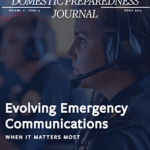- Articles, Critical Infrastructure, Emergency Medical Services, Fire, Hazmat, Hospitals, Law Enforcement, Public Health, Terrorism
- Rick C. Mathews
“Are we prepared?” is a simple question with a not-so-simple answer. There are generally two times this question arises: (1) when funding is being requested, and (2) after an incident occurs where the preparedness comes under review. Both timings are appropriate, but arguably not the best time to raise the question. The best time to ask this question is that “sweet spot” between a request for funding and an actual need arises. However, this ideal time is frequently missed or avoided. Some would say it is human nature to avoid tough questions unless forced to face them; other times, it is because of the preparedness issue conflicting with other priorities that comprise the agendas of most agencies, governments, and private sector managers.
Fruitful discussions of preparedness usually revolve around the concept of risk and its management. Those in the preparedness business understand that risk is a mix between two balances: (1) threat (frequency or likelihood of an occurrence and the consequences if it comes to fruition); and (2) cost (protection, prevention, mitigation) vs. benefit (degree of mitigation or avoidance altogether). These discussions appear to be straightforward but, like preparedness itself, are not typically simple.
As an example, consider a venue’s preparedness to potential active shooter attacks. Assume further that the location in question is a retail store that is dependent on foot traffic throughout the store. The determination is that an active shooter attack has never occurred on this property. However, it could occur and, if it happens, the consequences could be significant. One of the protection strategies proffered is to allow access to the store only via one doorway that is protected by both an armed guard and metal detection processes. This protection controls ingress and would project a deterrence posture and facilitate an immediate threat mitigation presence. One argument against the proposal is that the direct cost to implement the measure is very high, prohibitively so.
Moreover, the indirect loss associated with this measure is the certainty of a decrease in foot traffic and the resulting sales reduction. This loss is the direct result of potential customers not feeling as welcome in the modified environment. The proposed measures would likely reduce the consequences of an active shooter attack but would require financial costs that are too high. On a side note, another issue arises. An active shooter attack is a particular type of attack, one that involves one or more hostile assailant employing firearms as weapons. Consider a scenario where the attackers use weapons other than guns. Terminology does matter. Unless the discussion is specific to firearms, consider the term “active violence” as a broader approach that is inclusive of other weapons.
Planning for a Pandemic
The active violence scenario is important and one for which organizations and individuals should prepare. Unless the attack is coordinated (multiple locations) and/or complex (numerous weapon types or tactics), it is generally location specific in terms of prevention and protection, and more generalized if discussing the response mission. In contrast, consider the catastrophe of a pandemic. By its very nature, a pandemic or epidemic is pervasive, directly impacting communities, organizations, and families across a large geographical area – multiple states or countries. This type of event has occurred in the United States in 1918 (H1N1), 1957/1958 (H2N2), 1968 (H3N2), 2009 (H1N1pdm09), and now 2019/20 (COVID-19). Questions arise regarding the degree of preparedness of any particular state or the United States as a whole for the latest virus-driven pandemic. Unfortunately, this discussion did not occur during the so-called “sweet spot” timeframe. Instead, this discussion occurred (or at least was attempted) in the early part of this decade.
The bombing in Oklahoma City, Oklahoma on 19 April 1995 served as one wake-up call regarding preparedness in the context of terrorist attacks and the use of weapons of mass destruction (CBRNE). Congress passed the Nunn-Lugar-Domenici Act (Section 1402 of the Defense Against Weapons of Mass Destruction Act of 1966 – PL 104-201) on 23 September 1996. This act of Congress did many things, of which the establishment of the Office for Domestic Preparedness and the assessment of the nation’s 120 most populated cities for preparedness were significant. After the 9/11 attacks against the United States, President George W. Bush (#43) issued Homeland Security Policy Directive 1 (HSPD 1) on 29 October 2001. HSPD 1 established the Homeland Security Council to coordinate homeland security-related activities among executive departments and agencies. Later, after the establishment of the Department of Homeland Security, President Bush issued additional HSPDs, including HSPD-8, on 17 December 2003. The purpose of HSPD-8 was:
This directive establishes policies to strengthen the preparedness of the United States to prevent and respond to threatened or actual domestic terrorist attacks, major disasters, and other emergencies by requiring a national domestic all-hazards preparedness goal, establishing mechanisms for improved delivery of Federal preparedness assistance to State and local governments, and outlining actions to strengthen preparedness capabilities of Federal, State, and local entities.
HSPD-8 put into operation many activities. It addressed training and exercises, equipment needs, development of a National Preparedness Goal, and the start of an effort to develop capabilities across all-hazard preparedness.
Revisiting the National Planning Scenarios
The preparedness capabilities development effort tied to the National Planning Scenarios developed by the Homeland Security Council. This effort began in late 2001 and continued concurrently with the HSPD 8 efforts. Ultimately, draft 21.3 was labeled as the “final draft” in March 2006. The National Planning Scenarios included 15 all-hazard scenarios for use as planning tools. The national scenarios were not inclusive of all possible or probable events by design. They were of a mix that would likely encompass all of the critical capabilities required to handle any significant disaster, attack, or catastrophic event. HSPD-8’s efforts used the national scenarios as the basis for determining key or target capabilities as well as anticipated resource needs and other related preparedness efforts. Of the 15 national scenarios, Scenario #3 specifically addresses pandemics. Within that context, the Target Capabilities List (TCL) identified the following capabilities that have key ties to pandemics:

Source: DHS (2007).
- Epidemiological Surveillance and Investigation
- Laboratory Testing
- Critical Resource Logistics and Distribution
- Responder Safety and Health
- Isolation and Quarantine
- Emergency Public Information and Warning
- Emergency Triage and Pre-Hospital Treatment
- Medical Surge
- Medical Supplies Management and Distribution
- Mass Prophylaxis
- Fatality Management
- Economic and Community Recovery
An example is the Respond Mission Capability: Medical Surge. Specific to pandemics, selected examples of planning assumptions identified were:
- Pandemic is pervasive and not localized.
- Worst case scenario would produce 733,000 patients hospitalized on any given day.
- Up to 20 percent of those hospitalized (146,600 patients) are critical and will each require a critical care bed and mechanical ventilation, necessitating staff to patient ratios of 1:2 registered nurses (RN) (73,300 RNs), 1:10 physicians (14,660 MDs); 1:5 respiratory therapists (29,320 RTs). Ratios should be consistent with State/sub-State regions.
- 80 percent of those hospitalized (586,400 patients) are non-critical and will require a general medical bed, necessitating patient to staff ratios of 1:40 physician (14,660 MDs) and 1:20 RN (29,320 RNs).
- Vaccine availability will be insufficient and time to produce additional vaccine unacceptably long.
- Antiviral drug production will be surged.
- Strategic National Stockpile (SNS) will be depleted.
- There is a critical need for containment measures to prevent additional disease spread. Specific counter measures such as social distancing, masks, and hand hygiene should be instituted.
- Because of the limited supply and production capacity, there is a need for explicit prioritization of influenza vaccine based on the risk of influenza complications, the likelihood of benefit from vaccination, role as an influenza pandemic responder, and impact of the pandemic on maintenance off critical infrastructure.
- Primary prevention including masks, hand hygiene, and social isolation may be the primary mode of preventing the spread of disease if vaccine and viral agents are not available in adequate quantities.

Source: ©rcm Imaging (2020).
Development of the National Planning Scenarios occurred as a response to the newly formed Homeland Security Advisory Council following the 9/11 attacks and one of the council’s initial efforts to advise the president regarding steps to improve the nation’s preparedness capabilities. Subsequently, these scenarios served as a foundation for the creation of the TCL in large part as a response to Congress’ stated needs for a means of measuring the nation’s progress concern for preparedness efforts primarily funded through appropriations.
The work began in earnest in 2005 but, for some reason, ended without formal adoption of nor subsequent evolution of the target capabilities’ progress. To be sure, there were many skeptics of the TCL, especially regarding its associated measures and metrics, both of which were identified as guidelines only. In April 2020, within the context of the ongoing COVID-19 pandemic, several questions seem clear and are ripe for discussion but even more in need of solutions:
- Did America as a whole, and its states specifically, adequately plan for its fifth pandemic since 1918, in light of the National Planning Scenarios and the TCL?
- How different were the planning assumptions of the TCL (specifically Medical Surge) and COVID-19 (e.g., 146,600 critical patients requiring ventilators)?
- Should the United States consider another look at the National Planning Scenarios and the TCL’s planning assumptions as part of the planning and preparedness process?
No answers yet, just questions for everyone to ponder in the weeks and months ahead.

Rick C. Mathews
Rick C. Mathews is a principal in the Mathews Group LLC and serves as a public service professor in the Rockefeller College of Public Affairs and Policy at the at the University at Albany SUNY. He has over 40 years of experience in the areas of safety, security, counterterrorism, and emergency preparedness. He has trained emergency responders across the nation and has conducted research in emergency preparedness, homeland security, and critical infrastructure interdependencies. He serves as a consultant to both public and private sector clients, the media, and emergency responder agencies.
- This author does not have any more posts.






